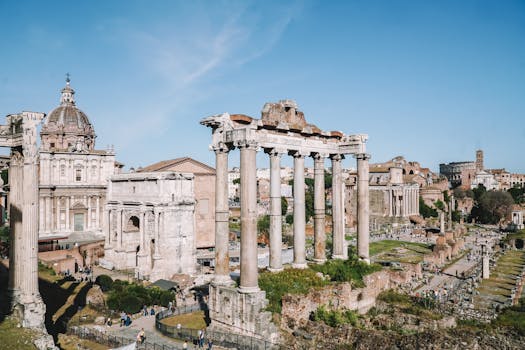Walking Through History: Exploring the Ruins of Rome
Rome, the Eternal City, stands as a testament to a civilization that once held sway over the known world. Its ruins, scattered across the cityscape, whisper tales of glory and grandeur, inviting the curious to step back in time and explore the remnants of an empire etched in stone. This journey through history is not just a walk among crumbling columns and ancient alleys; it's an immersive experience that breathes life into silent yet eloquent testimonies of Rome's majestic past.

The Colosseum, an iconic symbol of Rome's might and architectural prowess, is a must-visit for any history enthusiast. Once the stage for gladiatorial contests and public spectacles, this colossal amphitheater now stands as a poignant reminder of Rome's imperial era. The sheer size and intricate design of the Colosseum bear witness to the engineering skills of ancient Romans, making it a fascinating study for historians and architects alike.
Not far from the Colosseum lies the Roman Forum, another monumental ruin that offers a glimpse into Rome's political life. Once the hub of Roman public affairs, this sprawling complex housed government offices, temples, and marketplaces. Today, its ruins serve as silent sentinels guarding stories of political intrigue, religious rituals, and bustling commerce.
A walk through Rome's historic center would be incomplete without visiting the Pantheon. This remarkably preserved building is a testament to Rome's architectural genius. Its massive dome, punctuated by an oculus that lets in natural light, creates an awe-inspiring interior space that has been captivating visitors for centuries.
The Baths of Caracalla are another testament to Rome's advanced engineering. These public baths were more than just places for hygiene; they were social hubs where Romans could exercise, socialize, and even conduct business. The ruins of these baths give us insights into the daily life of ancient Romans.
Exploring Rome's ruins is akin to flipping through the pages of a living history book. Each ruin, from the grand Colosseum to the humble remnants of ancient homes, tells a story of a civilization that shaped the course of history. These ruins are not just lifeless stones; they are vibrant echoes of Rome's past, resonating with tales of triumphs and tragedies, of emperors and gladiators, of poets and philosophers.
The journey through Rome's historic ruins is more than an exploration; it's an experience that connects us with our shared human past. It reminds us of the impermanence of power and glory, the enduring legacy of art and culture, and the timeless value of knowledge and wisdom. As we walk through these ancient sites, we are not just spectators but participants in a narrative that spans millennia.
Rome's ruins stand as silent yet eloquent testimonies to an empire's grandeur and a civilization's achievements. They invite us to reflect on our own place in history and our contributions to humanity's ongoing narrative. As we explore these ruins, we don't just walk through history; we engage with it, learn from it, and carry its lessons into the future.
So lace up your walking shoes and embark on this unforgettable journey through history. Let Rome's majestic ruins guide you through the corridors of time, unveiling stories etched in stone and time. Whether you're a history buff or a casual traveler, Rome's ruins offer an enriching experience that transcends time and space. It's not just about exploring ruins; it's about connecting with our shared human heritage.
How to Get There
Reaching the heart of Rome's ancient glory is easier than one might think. Rome's Leonardo da Vinci International Airport, commonly known as Fiumicino, serves as the main gateway for international tourists. From there, you can catch a train directly to Roma Termini—the city's central station. For those who prefer the road less traveled, regional buses provide scenic routes into the city. Once in Rome, an efficient metro system, along with numerous bus lines, makes accessing historic sites quite convenient.
Key Places to Visit
The Colosseum, standing as a monumental marvel of Roman engineering and architecture, remains a pivotal first stop for any historical enthusiast. Not far from this grand arena lies the Roman Forum. Here, one can stroll through the cradle of Roman politics and culture. Continuing the exploration brings you to the Pantheon, where the light dances through its oculus—a true marvel of ancient architecture that has stood the test of time.
The Baths of Caracalla are next on your list, providing a fascinating glimpse into the public and hygienic customs of old Rome. Noteworthy for their advanced design and social significance, these baths were once a hub of Roman societal life and innovation.
Useful Websites to Visit
For those ready to embark on this historical journey, here are some top resources:
| Website Name | URL | Description |
|---|---|---|
| Rome Tourist Board | turismoroma.it | Official tourist info for all things Rome. |
| Rome Info | rome.info | A comprehensive guide to Rome's history and attractions. |
| Vatican Museums | museivaticani.va | Plan your visit to one of Rome’s most sacred sites. |
| The Roman Guy | theromanguy.com | Tours & tips from locals for experiencing Rome authentically. |